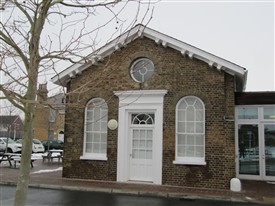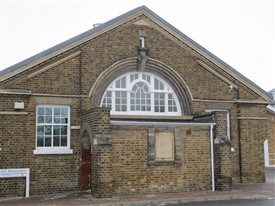Rochford Union Workhouse

Workhouse Chapel

Dining Hall, built 1912
By Sue Horncastle
Go directly to the Comments section
Rochford Union Workhouse was built in 1837 at a cost of £5000. It was intended to house 300 people. Less than fifty years later social conditions were slowly improving and the 1881 Census shows that there were only 172 inmates in addition to the Head of the workhouse, his wife and baby son, four officers and three visitors. Even the 82 year old 'late porter' of the workhouse ended up as an inmate. The census makes very sad reading.
There is not much left of the original Rochford workhouse, but what is still to be seen has an interesting past. Some of the former workhouse buildings including the chapel, dining room and some other areas are listed as buildings of historical and architectural importance so cannot be altered any further. They were listed when the old Rochford Hospital was threatened with closure in an attempt to prevent the redevelopment of the entire site.
A hundred years before the Welfare State was created there were still many people in society who needed help to survive. The elderly, orphans, the disabled, not to mention the unemployed had no state benefits to support them. Sole responsibility for providing essential support fell on the ratepayers of each parish where these people were born or ended up in destitution.
In fact, by the first quarter of the 19th century the entire population was growing rapidly. The rural population was increasing at the same time as rural employment was decreasing due to changes in agriculture and industry. More people needing help and less people to provide the rates to pay for it created major social problems. Similar social problems were found all over the country. The new industrial towns were even worse affected than rural areas as often they grew up in places with no parish church around which support could be organised. Often the parish ratepayers, in spite of the definition of 'deserving' or 'undeserving' which was attached to the poor, just could not afford to support increasing numbers of destitute people in their own homes.
The solution seemed to be to combine, or unite, the resources of several local parishes and create a Union Workhouse to provide for all the needy in one place. The able bodied were to be put to work and the sick or disabled were cared for in what would be seen now as very rudimentary conditions. Workhouse life was meant to be tough and humiliating as a deterrent to malingerers. Going into the workhouse became the shameful last resort of the desperate.
By the time of the 1881 census there were 85 men, 41 women and 46 children housed in the Rochford Union Workhouse. The oldest inmate was a widow of 94 and the youngest a child of one year. There are shown to have been nine 'imbeciles' and one 'deaf and dumb' woman. Contrary to popular belief, families are not shown as particularly numerous but several of the children appear to be orphans. In one family of four the oldest is a girl of 16 and the others are aged eight, six and three. Another family's ages are 16, 14, 10 and five. In yet another, two Hawkwell brothers were without parents at the ages of 11 and five years. Nearly all the inmates were born in the parishes which are now in the Rochford District but some came from the Southend or Benfleet areas and other parts of Essex. In 1881 very few were from further afield.
Families were separated on going into the workhouse: men in one part; women and children in another. Caring for the poor and needy was still a major expense for ratepayers so it was done as cheaply as possible. Those who could were made to work at the most menial and unpleasant jobs to earn their keep. Workhouse inmates were made to feel outside decent society; they wore a distinctive uniform and were all paraded in a 'crocodile' to church on Sundays where they sat in separate pews so everyone in the rest of the congregation could see their situation. Similarly, the children were picked out at school for humiliation as workhouse inmates
Some adults were put to work in the workhouse buildings as charwomen or maids but 'picking oakum' was the most usual occupation as it was useful to society but extremely hard and unpleasant. Oakum was old, rotten, salty and tarry pieces of broken, worn out hemp rope which had been used, among other things, for the rigging of ships. The oakum was separated by hand into fibres which could then be remade into new ropes. Hundreds of miles of rope were needed each year for all sorts of uses, not just seafaring and this was seen as an excellent use of free labour which, due to the crime of destitution, did not deserve anything better.
Children were apprenticed or otherwise put to work in homes, shops and farms as soon as they reached the end of compulsory education. There is evidence of some very young Essex orphans being taken to Lancashire to work in the cotton mills. In the early years of the Rochford Union Workhouse schooling ended at the age of 11 years but by the time of the 1881 Census the school leaving age was 14. Workhouse children would have lived in at their employer's expense and were often treated little better than slaves. (As Charles Dickens so clearly demonstrates, particularly in Oliver Twist.)
The Rochford Workhouse was extended and altered over the years eventually becoming part of Rochford Hospital. Not so long ago some of the buildings were still used as geriatric wards. This must have been particularly upsetting for elderly people who remembered the humiliation and disgrace attached to those who were classed as workhouse inmates well within their lifetimes.
Many people today will hardly notice the narrow road at the bottom of West Street when they cross to the supermarket or station. If they do notice, the name Union Lane is a reminder of the harshness of the lives of the poor before the coming of the Welfare State.